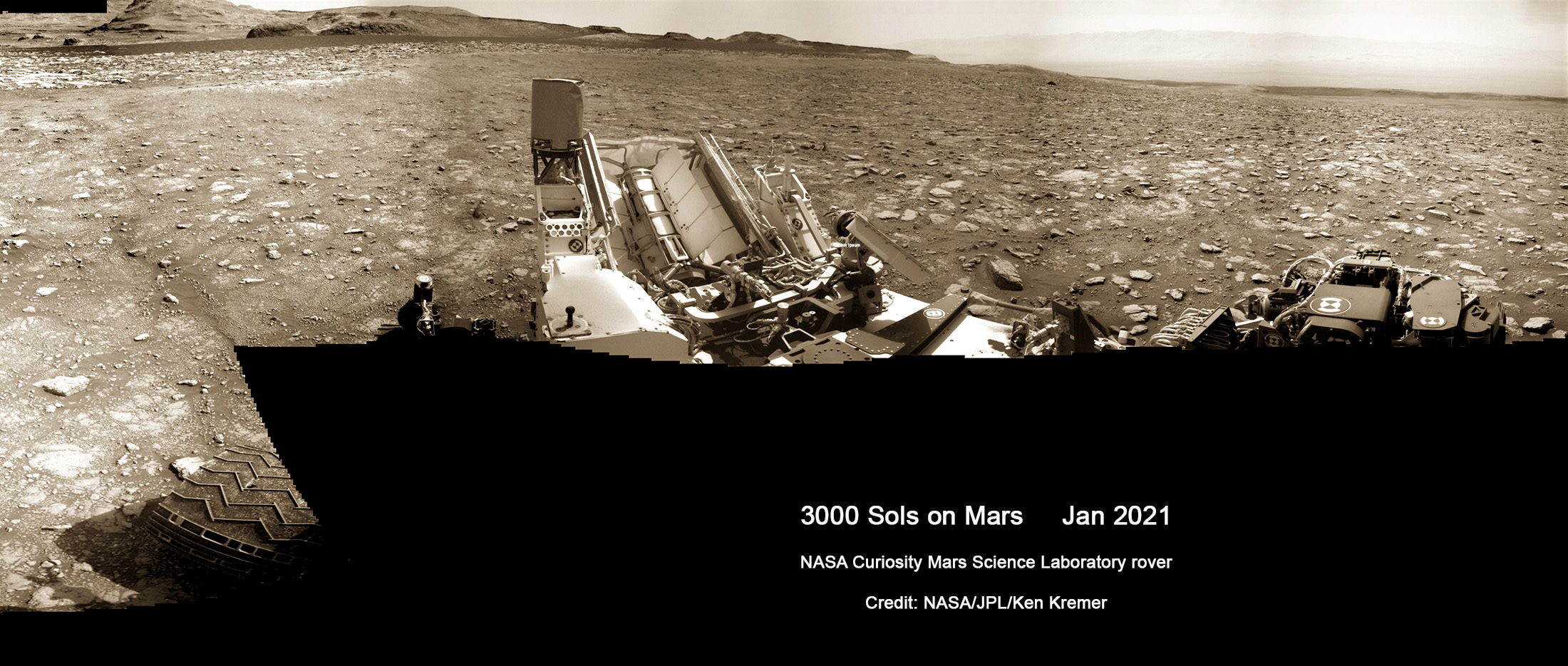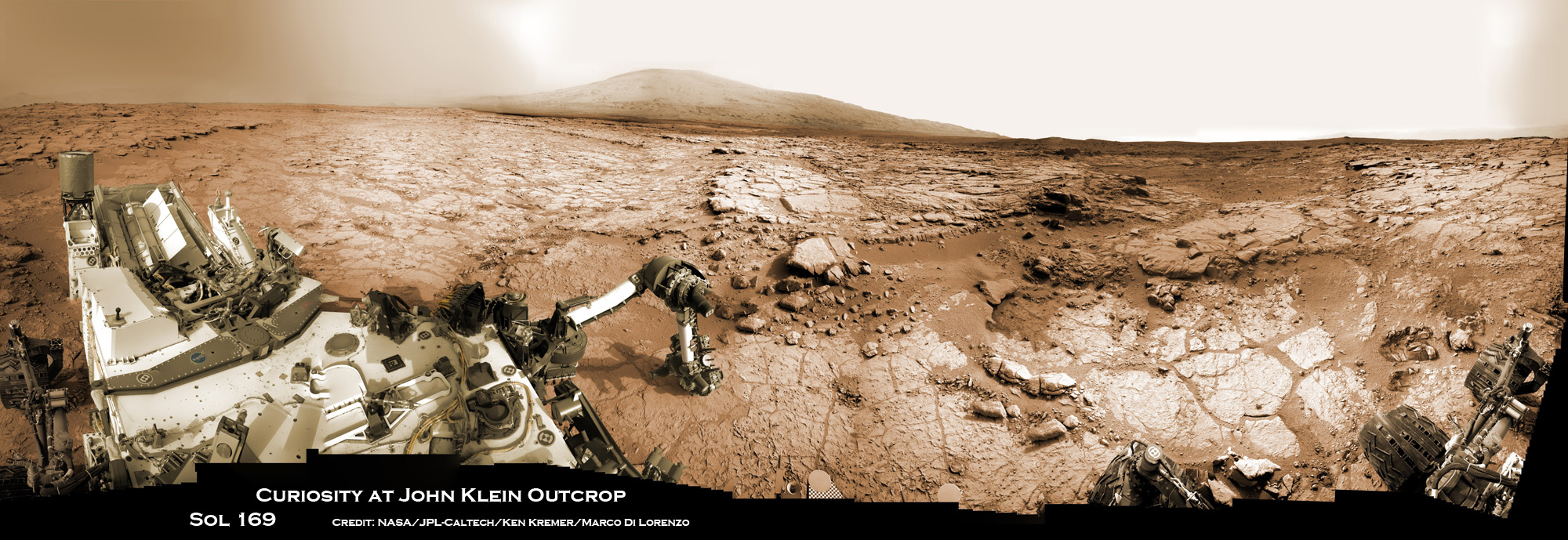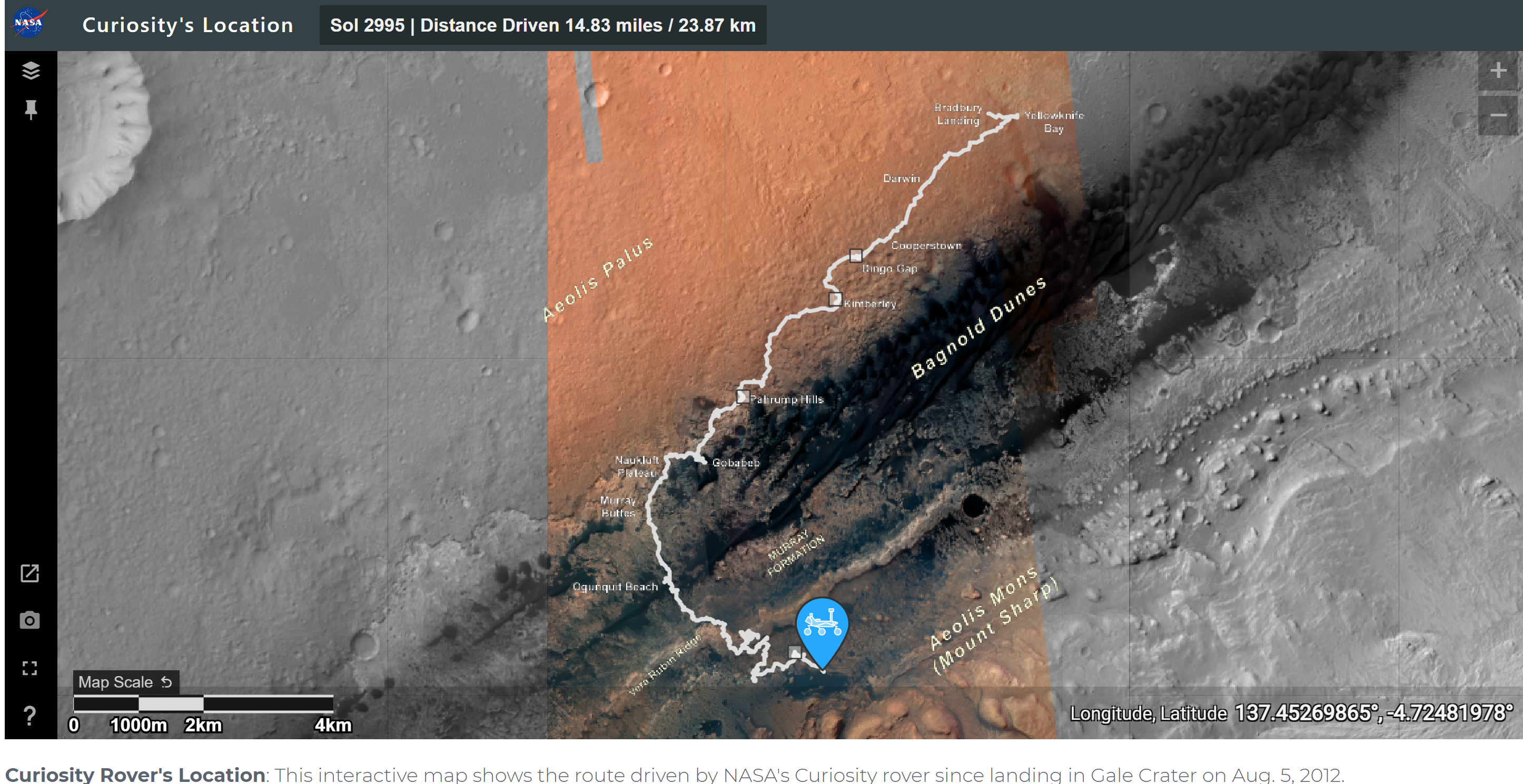
For SpaceUpClose.com & RocketSTEM
CAPE CANAVERAL, FL – The view from Mars on Sol 3000 – simply spectacular !!! As she snapped a dramatic new self portrait backdropped by alien scenery from the Red Planet
NASA’s groundbreaking Curiosity rover is celebrating 3000 Sols, or Martian days, of exploration on the Red Planet since she touched down on Mars on Aug. 6, 2012 inside Gale Crater with the goal of climbing Mount Sharp in search of sign of water and organic molecules and potential signs of past life.
To mark the marvelous achievement, I’ve created a new Curiosity rover self portrait mosaic from her raw images to show the scientifically scrumptious scene she witnessed now on Jan. 12, 2021 or the 3000th Martian day (Sol 3000).
See my lead mosaic image above and a wider panoramic mosaic below to experience the current scene at ground level – stitched together from navcam raw images taken by the left navigation camera on the robots masthead and subsequently transmitted and received back on Earth on Jan. 14.

Mount Sharp dominates Gale Crater and exploring the lower levels shaped by past water episodes of liquid water is the primary research goal of the mission.
Curiosity is currently exploring the lower sedimentary layers of Mount Sharp which tower over 3 miles (5.5 km) into the Martian sky.
Gale Crater is the 96-mile-wide (154 kilometer-wide) bowl that Mount Sharp sits within.
Mount Sharp has rock layers that were shaped by lakes and streams billions of years ago, according to NASA scientists.
“Like sands through the hourglass, so are the sols of our lives. Can you believe I’ve been here for 3,000 Martian days? Here’s a recent panorama marked by curved rock terraces, or benches. These formations aren’t just scenic; they tell of ancient Mars,” NASA tweeted.
Like sands through the hourglass, so are the sols of our lives. Can you believe I've been here for 3,000 Martian days?
Here's a recent panorama marked by curved rock terraces, or benches. These formations aren't just scenic; they tell of ancient Mars. https://t.co/oGFwQzz0A5 pic.twitter.com/iwK5Ir6jGX
— Curiosity Rover (@MarsCuriosity) January 13, 2021
“It’s been an exciting 3,000 sols so far, and I look forward to seeing what else we’ll discover as Curiosity continues to climb Mt. Sharp. Tonight I’ll be raising a glass to Curiosity and the science and engineering teams that have gotten us this far!” wrote Curiosity researcher Lauren Edgar, Planetary Geologist at USGS Astrogeology Science Center, in the mission blog
Curiosity achieved the magnificent 3000 Sol milestone even as her younger sister rover Perseverance is barreling toward the Red Planet and is now just 5 weeks away from landing on Feb. 18, 2021 inside Jezero Crater.
What are some of the science highlights during these 3000 sols?
The first drill in Yellowknife Bay… finding evidence of an ancient, flowing stream at Hottah… crossing the Dingo Gap… roving amid Murray Buttes… climbing to the top of the Greenheugh Pediment… so many sols, so much more to explore. pic.twitter.com/ytB3ApEwkC
— Curiosity Rover (@MarsCuriosity) January 13, 2021
Here is our mosaic from the 1st Curiosity drilling at the John Klein outcrop on Sol 169 in Feb. 2013.

This past year the car sized Curiosity rover has been driving across a clay-bearing region called “Glen Torridon” and previously dubbed the ‘clay-bearing unit’

Clay minerals form in more neutral pH water
Before that the six wheeled rover had moved on from Vera Rubin Ridge.
‘Glen Torridon’ sits in a trough just south of the ridge. Clay minerals in this unit may hold more clues about the ancient lakes that helped form the lower levels on Mount Sharp.
“As the rover has continued to ascend Mount Sharp, it’s found distinctive benchlike rock formations.”
“After making a pit stop at a location nicknamed “Mary Anning,” it’s continued toward the next major layer, called “the sulfate-bearing unit,” NASA officials said as she scales Mount Sharp.
The sulfate unit minerals formed in more acidic pH water.

Curiosity is “exploring the curved rock terraces that define the area can form when there are harder and softer layers of rock on a slope. As the softer layers erode, the harder layers form small cliffs, leaving behind the benchlike formations. They can also form during a landslide, when huge, curved slabs of bedrock slide downhill. Curiosity’s team has seen benches before in Gale Crater, but rarely forming such a scenic grouping of steps.”
NASA published a mosaic of images taken on November 18, 2020, on Sol 2946.

“Our science team is excited to figure out how they formed and what they mean for the ancient environment within Gale,” said Curiosity’s project scientist, Ashwin Vasavada of NASA’s Jet Propulsion Laboratory in Southern California, which built and manages the rover.
The rover’s current home, Glen Torridon, is in a trough between Vera Rubin Ridge and the rest of the mountain. This region had been called the clay-bearing unit because orbiter data show that the rocks there contain phyllosilicates — clay minerals that form in water and that could tell scientists more about the ancient lakes that were present in Gale Crater off and on throughout its early history.
“In addition to indicating a previously wet environment, clay minerals are known to trap and preserve organic molecules,” said Curiosity Project Scientist Ashwin Vasavada of JPL. “That makes this area especially promising, and the team is already surveying the area for its next drill site.”
“The rover keeps making new discoveries during its gradual climb up Mount Sharp, the 3-mile-tall (5-kilometer-tall) mountain it has been exploring since 2014,” said NASA.
Curiosity has found both clay minerals and organic molecules in many of the rocks it has drilled since landing in 2012. Organic molecules are the chemical building blocks of life. If both water and organic molecules were present when the rocks formed, the clay-bearing unit may be another example of a habitable environment on ancient Mars — a place capable of supporting life, if it ever existed.
As of Sol 3000, Jan 12, 2021 Curiosity has driven over 14.83 miles (23.87 kilometers) since its August 2012 landing inside Gale Crater from the landing site to Mount Sharp and taken over 389,500 amazing images.

Following the demise of the Opportunity rover killed by a planet encircling dust storm after 15 exciting years of exploration, Curiosity is NASA’s only function rover operating on the Red Planet.
The stationary InSight lander also continues science operations.
Watch Ken’s continuing reports about NASA missions and Artemis, Mars Perseverance and Curiosity rovers, SpaceX, Commercial Crew and ISS and onsite for live reporting of upcoming and recent SpaceX and ULA launches including Crew1 & 2 and Starliner, X-37B, Solar Orbiter, NRO spysats and more at the Kennedy Space Center and Cape Canaveral Space Force Station.
Stay tuned here for Ken’s continuing Earth and Planetary science and human spaceflight news: www.kenkremer.com –www.spaceupclose.com – twitter @ken_kremer – email: ken at kenkremer.com
Dr. Kremer is a research scientist and journalist based in the KSC area, active in outreach and interviewed regularly on TV and radio about space topics.
………….
Ken’s photos are for sale and he is available for lectures and outreach events
Please consider supporting Ken’s work by donating at Patreon:
https://www.patreon.com/kenkremer
x



